Key takeaways:
- Storytelling in photography involves capturing emotions and narratives that resonate with viewers, using personal experiences to enhance connections.
- Effective visual storytelling relies on techniques like perspective, light, movement, and thoughtful subject matter to evoke deep emotional responses.
- Composition and careful lighting choices can significantly impact the narrative, enhancing the emotional depth and poignancy of photographs.
- Focusing on details and the intentionality behind the story aids in creating compelling images that reflect authenticity and layered human experiences.
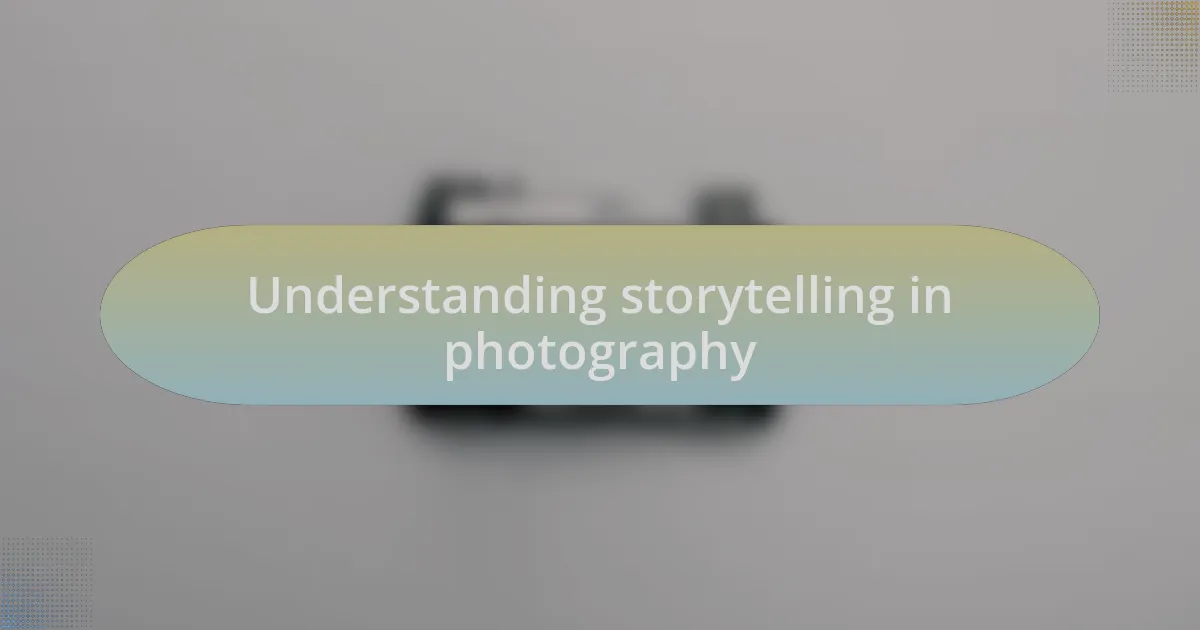
Understanding storytelling in photography
Storytelling in photography is about creating a narrative that resonates. I remember capturing an elderly couple holding hands on a park bench—something so simple yet profound. It made me think, what stories lie behind their smiles and emptiness? Every image is a fragment of a bigger tale, inviting viewers to pause and connect emotionally with the subjects.
When I frame a shot, I often ask myself what emotions I want to evoke. Is it joy, nostalgia, or perhaps longing? For instance, I once photographed a child playing in the rain, and the image conveyed a whimsical sense of freedom, evoking my own childhood memories of splashing in puddles. By tapping into personal experiences, I find that my photos become windows into shared human experiences.
Understanding storytelling in photography also means considering composition and light. Each element you include or exclude tells a part of the story. I learned this during a sunset shoot; the way the colors blended in the sky seemed to whisper of endings and new beginnings. I couldn’t help but wonder, how can we use these visual tools to guide the viewer’s journey through our photographs?
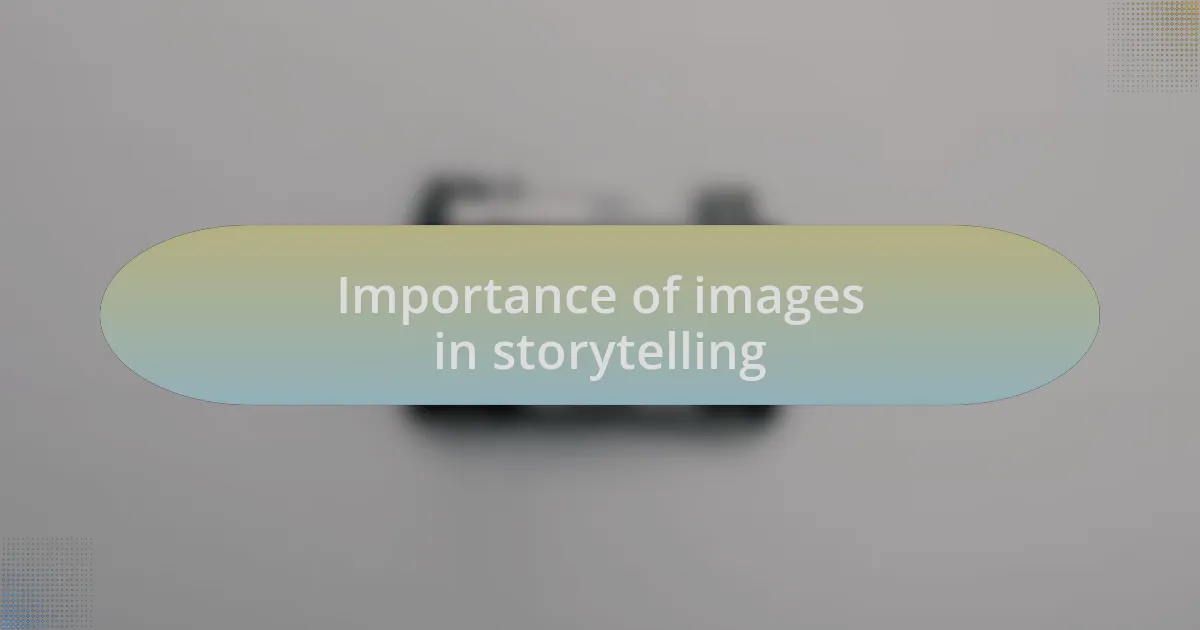
Importance of images in storytelling
Images play a crucial role in storytelling because they transcend language barriers, conveying emotions and narratives instantly. I recall a time when I captured a lone fisherman at dawn, silhouetted against the rising sun. The image told a powerful story of solitude and perseverance—the quiet struggle we all face in pursuit of our passions. It made me think, how often do we overlook the beauty in moments like this that speak volumes without a single word?
When you think about a photograph, consider how it can ignite memories or feelings in the viewer. I once took a shot of a bustling market, with vibrant colors and animated faces. The chaos captured in that frame transported me back to my childhood, stirring nostalgia for the vibrant traditions of my family. Isn’t it fascinating how a single snapshot can evoke such rich personal histories in others, too?
Imagery enhances storytelling by inviting interpretation. For instance, I found myself photographing a gravel path winding through a misty forest, a visual metaphor for life’s uncertainties. This made me ponder—what decisions lie ahead for the viewer as they step into that image? It underscores how effectively an image can spark curiosity and reflection, weaving each viewer deeper into the narrative I aim to convey.
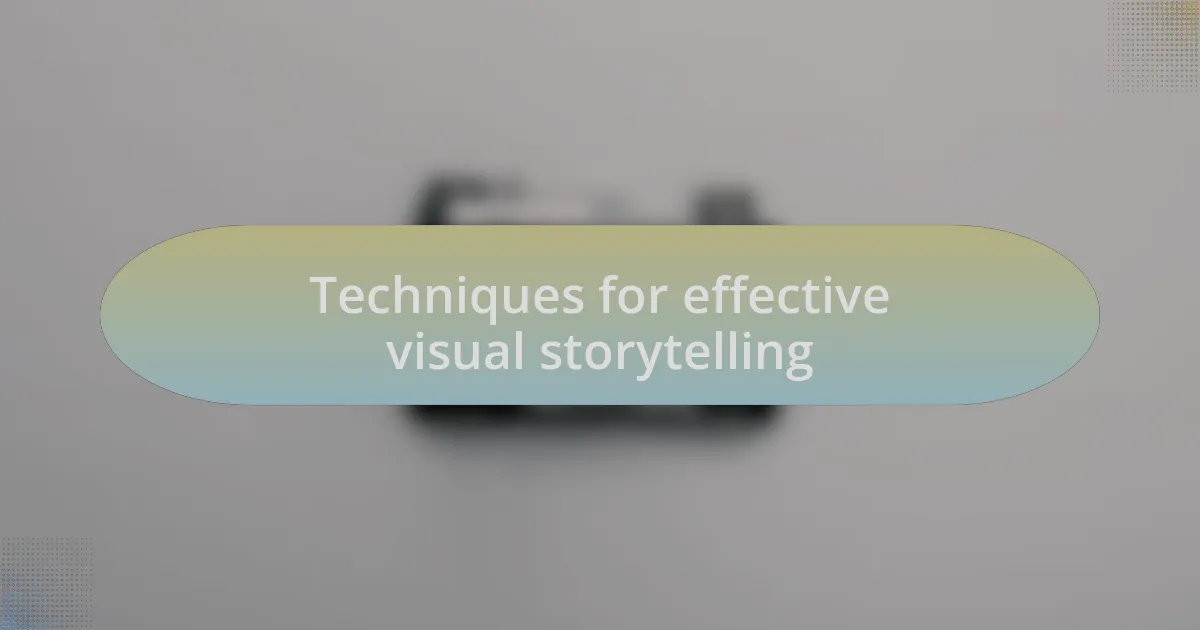
Techniques for effective visual storytelling
One effective technique in visual storytelling is the use of perspective. I once shot a photo from a low angle, capturing my son reaching out to a giant sculpture at a park. The towering figure loomed over him, emphasizing the theme of childhood wonder. It made me realize how perspective not only shapes the visuals but also influences the emotional impact on the viewer—how does our vantage point alter our understanding of a story?
Light is another powerful tool in storytelling. I remember a time when I experimented with backlighting during a sunset shoot. The warm golden rays illuminated the subject, creating an ethereal quality. This kind of dramatic lighting can evoke a sense of nostalgia or hope. How does light transform an ordinary scene into something extraordinary, compelling the viewer to reflect on their personal experiences?
Incorporating movement can also enhance your narrative. For instance, I captured a fleeting moment of a dancer leaping through the air, her hair spiraling around her like a whirlwind. In that split second, the image encapsulated both freedom and grace. It got me thinking, how can capturing movement breathe life into still images, drawing the viewer into the story and making them feel the energy of the moment?
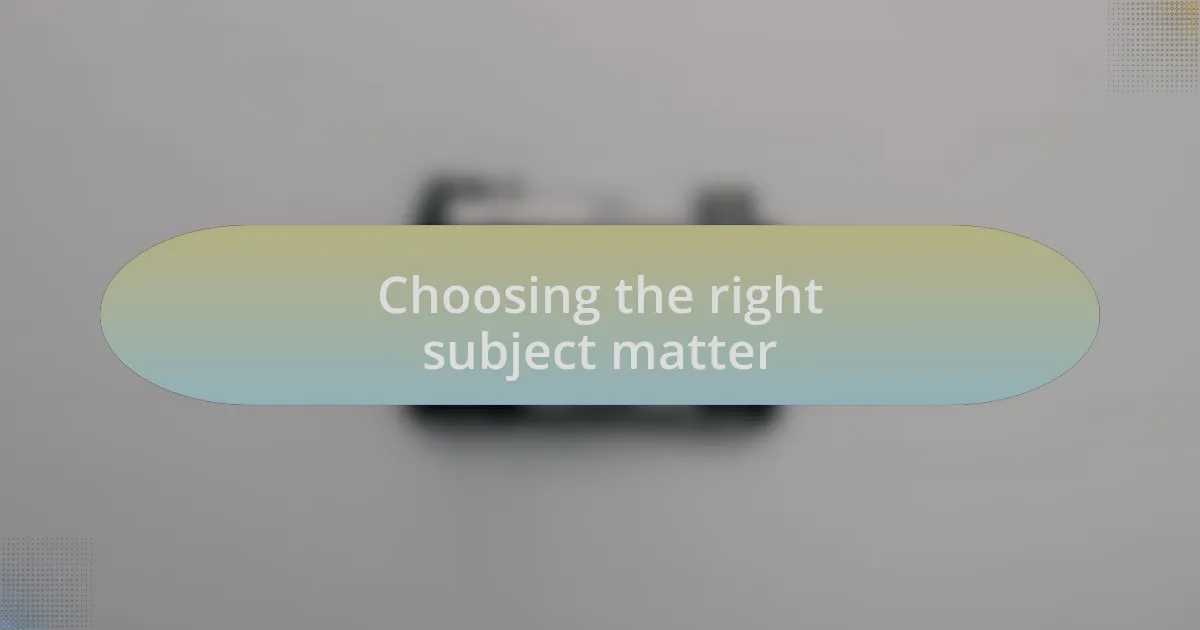
Choosing the right subject matter
When it comes to choosing the right subject matter, I often narrow my focus to what truly resonates with me. Once, I found myself drawn to an elderly couple sitting on a park bench, sharing quiet laughter. Their genuine interaction spoke volumes—what better way to convey love and companionship than through such tender moments? I realized that the emotional connection I felt while capturing their joy translated into a compelling image that viewers could relate to.
Not every subject will evoke the same feelings in everyone, so it’s important to consider your audience. During a street photography session, I decided to capture the hustle and bustle of a city market. I aimed to highlight not only the vibrant colors and textures but also the expressive faces of the vendors. It made me wonder; how can we select subjects that resonate with shared human experiences, bridging gaps between different perspectives?
I also believe that the story behind the subject can elevate the photograph. For instance, I once photographed a young artist painting a mural on a brick wall. As I learned about her journey of self-expression and community engagement, the image transformed in my mind from just a moment to a powerful narrative of creativity and resilience. Isn’t it fascinating how a deeper understanding of your subject can enrich the storytelling potential of an image?
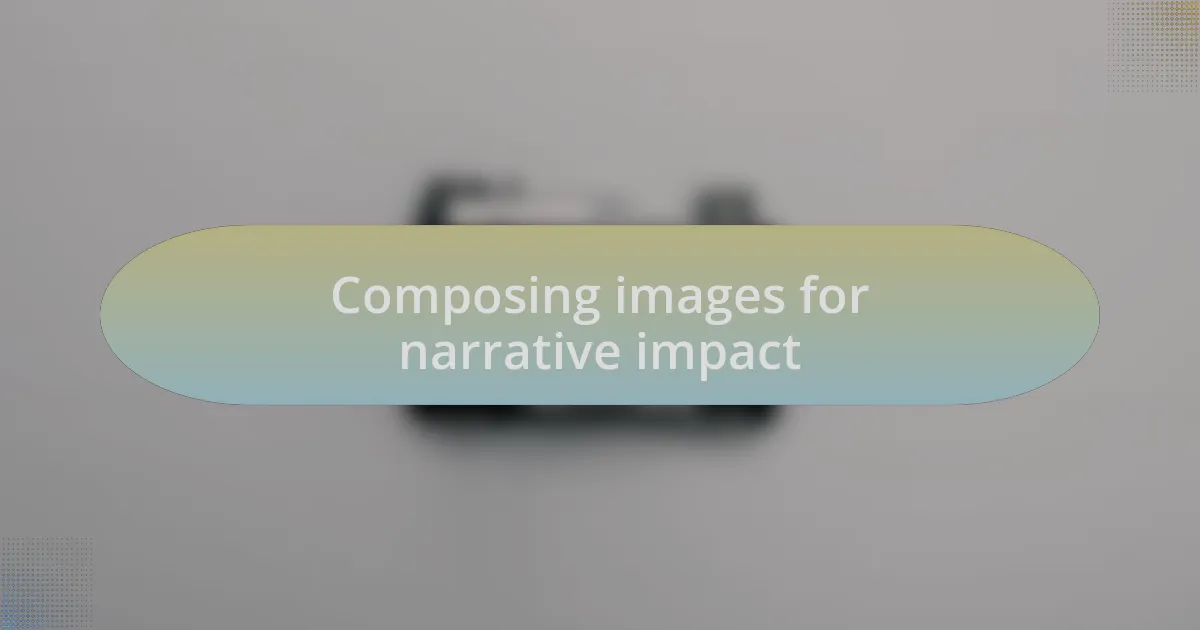
Composing images for narrative impact
When I compose an image, I often think about the visual elements that will enhance the narrative. I recall one time framing a lone tree against a vibrant sunset, which created a sense of solitude that resonated deeply. This stark contrast between the tree and the colorful sky left viewers pondering the story behind that isolated figure. Isn’t it intriguing how a simple change in composition can evoke profound emotions?
Finding balance among the elements in my frame often requires careful consideration. For instance, I once captured a busy intersection, but by blurring the background, I emphasized a child holding a balloon amidst the chaos. This decision not only drew attention to the innocence of the child but created a narrative tension between simplicity and the overwhelming world around us. How often do we find stories hidden in the interactions of our surroundings?
Lighting plays a crucial role in storytelling, too. I remember taking a photograph during the golden hour—a time just after sunrise or before sunset when the light is soft and warm. The way it illuminated a father teaching his daughter to ride a bike transformed the image into a moment filled with warmth, love, and growth. In this instance, the light didn’t just enhance the composition; it infused the scene with emotional depth. What stories can your lighting choices tell?
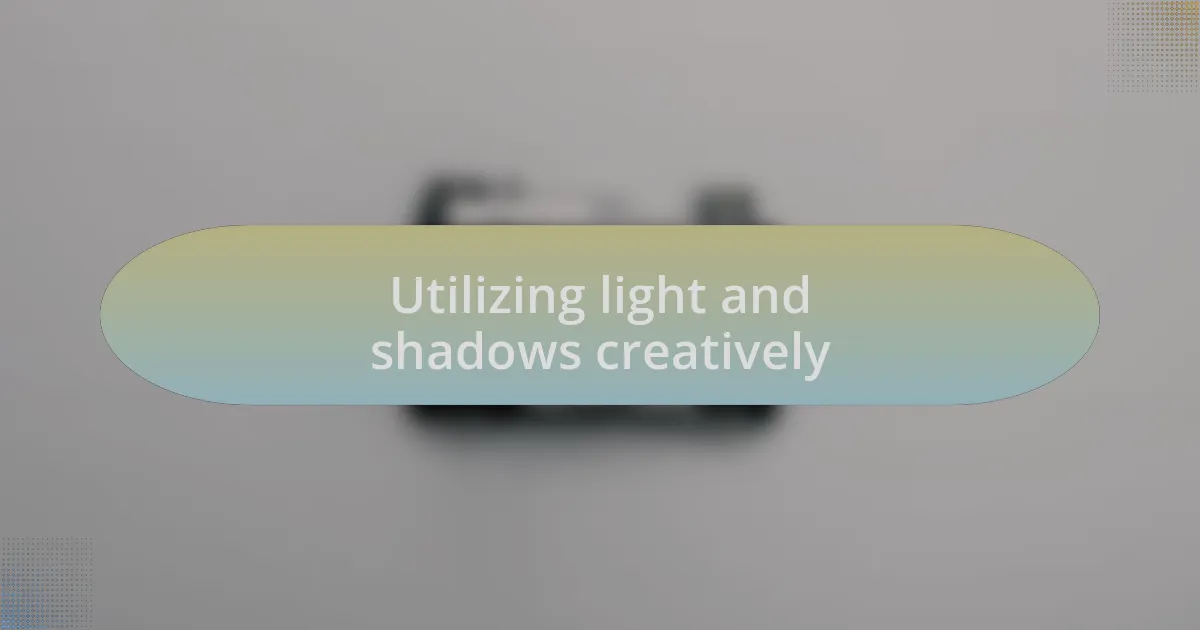
Utilizing light and shadows creatively
Utilizing light and shadows creatively can dramatically alter the perception of an image. I remember a time when I placed my subject against a window on a rainy day. The soft, diffused light filtering through the droplets created an ethereal glow while the shadows danced softly against the walls. This interplay not only added dimension but also invoked a mood of contemplation and nostalgia. Isn’t it fascinating how shadows can whisper stories that light sometimes shouts?
Every photographer knows that shadows can be just as telling as the subjects themselves. On one occasion, while exploring an abandoned building, I noticed how the beams of light broke through the dilapidated roof, casting intricate patterns on the floor. I deliberately framed my shot to focus on those shadows, accentuating the textures of the peeling paint and dust motes. This unexpected combination narrated the passage of time and decay, turning what might have been a mundane shot into a poignant reflection on memory and loss. Have you ever considered how shadows can serve as silent narrators in your own images?
In my experience, the quality of light significantly shapes viewer emotions. I once photographed a couple during a late afternoon, capturing their laughter just as the sun dipped below the horizon. The warm glow of the setting sun wrapped around them, creating a romantic halo, while the shadows elongated behind them, telling a story of fleeting moments and impending dusk. As I look back at that image, I realize that it’s not just about what’s visible but also what’s implied through light and shadow. How can your own choice of lighting transform the emotional landscape of your photographs?
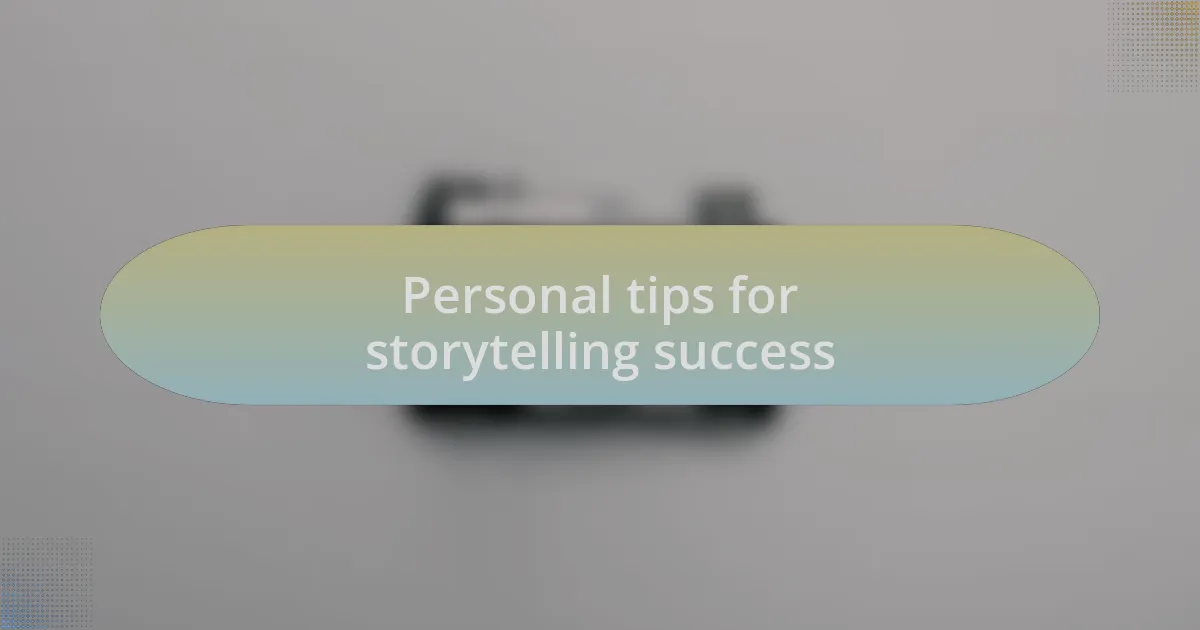
Personal tips for storytelling success
One key tip I’ve embraced in storytelling through images is to focus on the details within the frame. During a recent trip to a bustling market, I was captivated by a humble fruit vendor carefully arranging her vibrant produce. Instead of wide shots, I zoomed in on her weathered hands and the splashes of color from the fruits, creating a scene that spoke volumes about hard work and passion. Isn’t it amazing how a closer look can reveal layers of human experience that a broader perspective might miss?
I’ve also found that the choice of perspective can dramatically enhance the narrative. There was a moment in an urban park where I shot a child playing, but instead of standing at eye level, I knelt down to capture the world from her height. The image transformed as grass blades framed her laughter, bringing the viewer right into her joyful moment. Have you considered how shifting your viewpoint might change the story you want to tell?
Lastly, I suggest being intentional about the story you want to convey before pressing the shutter. Reflecting on a portrait I took during a family gathering, I realized I had a vision of capturing authenticity. I engaged with the subjects, sharing stories and jokes to elicit genuine expressions. The result was a set of lively portraits that reflected their personalities beautifully. How often do we think about the narrative we wish to tell even before we capture it?